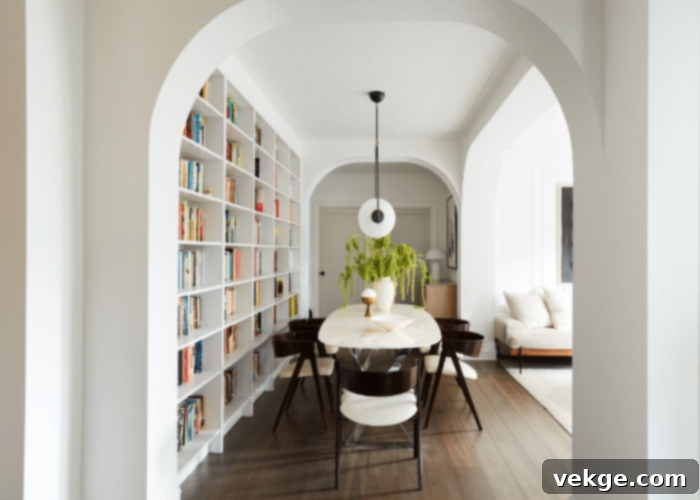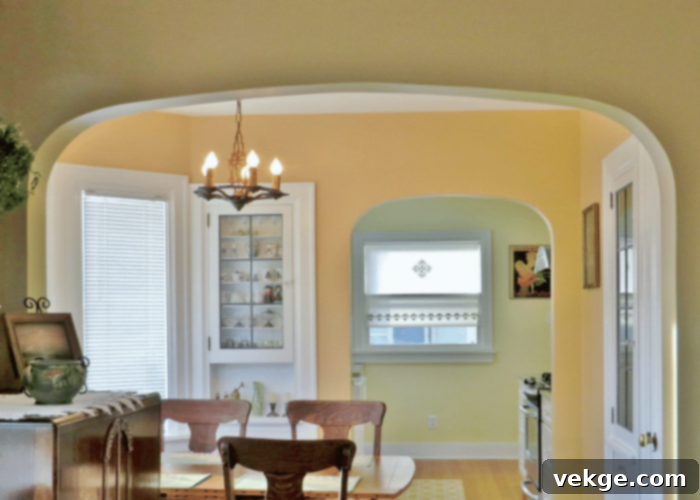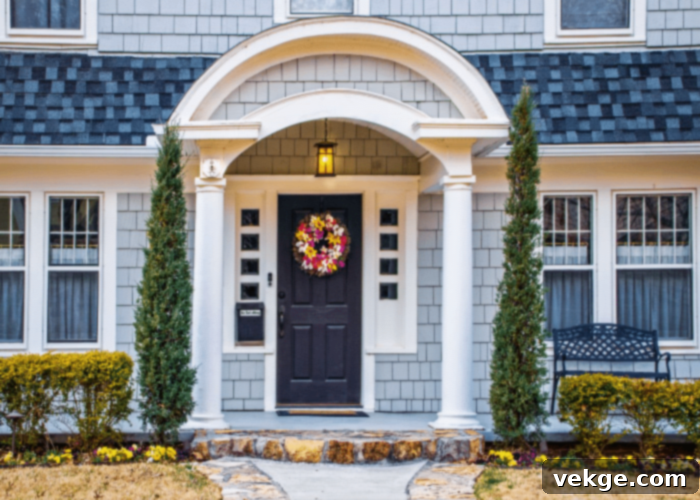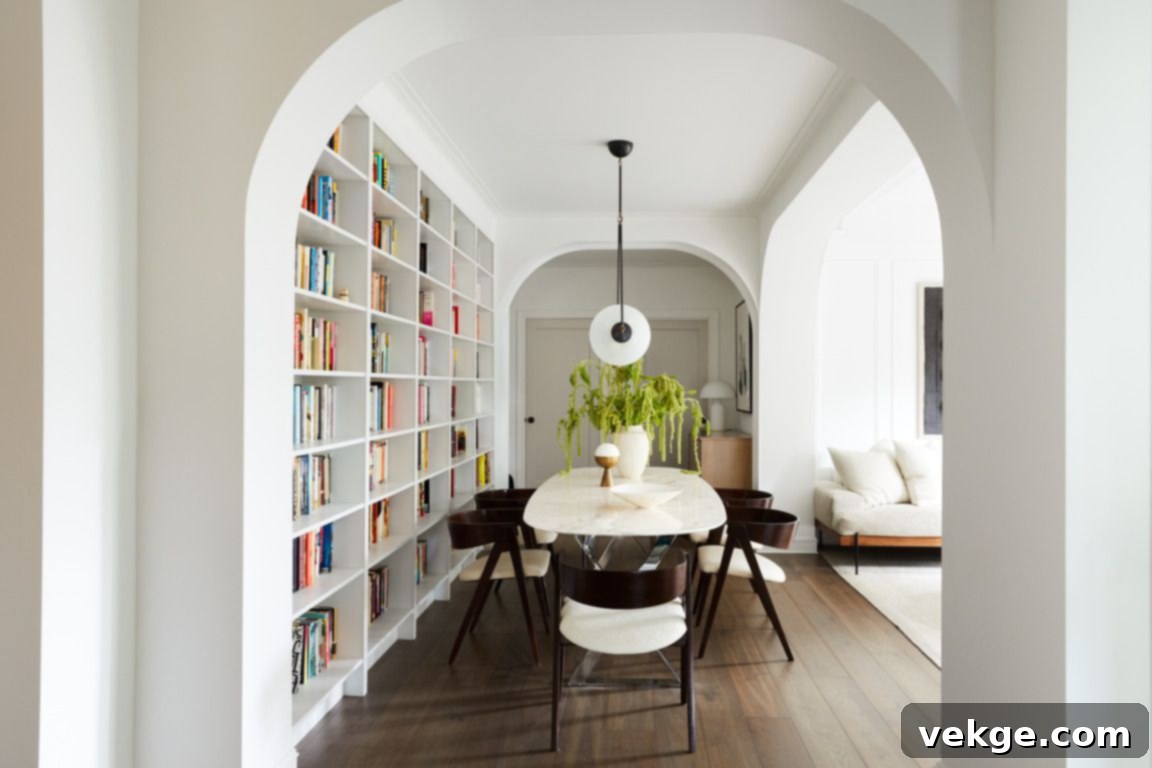The Timeless Allure of Arched Doorways: A Guide to Incorporating Classic Curves in Modern Homes
In the dynamic world of interior design, professionals are constantly seeking innovative ways to infuse spaces with character, elegance, and a refreshing sense of style. While sometimes this quest leads to groundbreaking new inventions, often it involves revisiting beloved elements from the past. One such “blast from the past” that has gracefully re-entered the spotlight is the majestic arched doorway. Far from being a mere relic of ancient times, these beautiful curved openings are experiencing a significant resurgence, becoming a defining feature in the finest contemporary interiors.
The journey of the arched doorway dates back millennia, with its origins deeply rooted in the architectural innovations of the ancient Roman period. Revered for their impressive aesthetic qualities and undeniable structural integrity, it’s hardly surprising that these historical features are once again capturing the imagination of designers and homeowners alike. They offer a unique blend of historical grandeur and modern sophistication, effortlessly bridging the gap between eras.
If you’re intrigued by the rising popularity of arched doorways and curious about how this captivating design element can transform your living space, you’ve come to the right place. This comprehensive guide will delve into everything you need to know about arched doorways, from their fundamental definition to their myriad benefits and practical applications in today’s homes. Prepare to explore how these elegant curves can add unparalleled charm and an inviting atmosphere to your interior.
Understanding the Essence of an Arched Doorway

At its core, an arched doorway is an opening that features a curved top, deviating from the more common rectangular or square shape. Instead of sharp 90-degree angles, it presents a graceful, continuous line, often resembling a segment of a circle or an ellipse. These architectural elements are typically found at the entrances of homes, serving as grand thresholds, or within interiors, marking the transition between adjoining rooms. They instantly elevate an otherwise ordinary passageway, imbuing it with a distinct traditional and classic aura.
Interior designers are particularly drawn to arched doorways because they possess an uncanny ability to captivate attention. By introducing an unexpected, soft curve into the predominantly rectilinear geometry of most rooms, arches create a visual focal point that is both striking and harmonious. They effectively soften the often-crisp, angular lines of walls, ceilings, and furniture, introducing an organic flow and a sense of gentle movement within a space. This subtle yet powerful design choice can transform a utilitarian opening into a sculptural statement.
Historically, arched structures were not merely decorative; they were celebrated for their superior strength and efficiency in weight distribution compared to flat lintels. This engineering prowess explains their widespread adoption in ancient civilizations across Asia, Europe, and the Middle East, from monumental Roman aqueducts to intricate Gothic cathedrals. Beyond their proven sturdiness, these doorways have consistently been admired for their enduring charm and naturally artistic appearance. They lend a home a sophisticated, softer, and often more artistic appeal that speaks volumes about its character.
Why Incorporate an Arched Doorway into Your Interior?
The appeal of an arched doorway extends far beyond its ability to invite attention and provide a traditional, classic aura. This elegant architectural feature offers a multitude of practical and aesthetic benefits that can significantly enhance your home. Let’s explore some of the compelling reasons why arches are an exceptional choice for modern interiors:
1. It Creates an Illusion of Expansive Space

One of the most remarkable qualities of arched doorways is their capacity to make a space feel significantly larger and more open. The inherent curve draws the eye upwards, creating a perception of greater vertical height than traditional flat-topped openings. Furthermore, because they often extend higher or appear wider than standard doors, they offer a more expansive view into the adjacent room. This visual trick subtly merges two spaces, fostering a sense of continuity and fluid movement, which is highly desirable in modern open-concept living plans. By offering a grander vista, arches effortlessly facilitate the coordination and flow between different areas of your home, making each room feel like a natural extension of the next.
2. Significantly Enhances Aesthetic Appeal

The primary driving force behind the comeback of arched doorways in contemporary interiors is undeniably their profound aesthetic impact. These graceful structures possess an unparalleled ability to uplift and transform a space, adding a layer of sophistication and visual interest that few other architectural elements can match. They instantly imbue your home with a sense of classical grandeur, a touch of old-world charm, or even a sleek, modern softness, depending on the surrounding decor. If your goal is to create a truly memorable and lasting impression with your interior design, incorporating elements like an arched doorway is a brilliant strategy. They become a natural focal point, guiding the eye and adding a sculptural quality that elevates the entire room’s ambiance.
3. Beautifully Complements Other Architectural Elements

One of the unsung heroes of arched doorways is their remarkable versatility in harmonizing with a wide array of existing architectural details. While they stand out as unique features, they also possess the ability to integrate seamlessly or create compelling contrasts. For instance, in a room dominated by strong, rectilinear elements like a square-framed fireplace, rectangular windows, or sharp-edged furniture, an arched doorway can introduce a vital sense of balance. Its soft, flowing curve gracefully offsets the rigidity of straight lines, preventing the space from feeling too harsh or predictable. This interplay of geometric shapes adds depth and dynamic visual interest, allowing both the arch and the surrounding elements to shine while creating a cohesive and thoughtfully designed environment. Whether you’re aiming for synergy or deliberate contrast, arches offer an elegant solution.
4. Provides Inherently Superior Strength

Beyond their aesthetic merits, arched doorways are renowned for their inherent structural integrity. The fundamental engineering principle behind an arch—distributing weight outwards and downwards to its supports—makes it incredibly strong and capable of bearing substantial loads. This is a proven fact demonstrated by countless ancient structures that have stood for centuries, if not millennia. Historically, arches were widely preferred by master builders for their durability and stability, a preference that allowed them to withstand the test of time. While in many modern homes, a doorway arch might be more decorative than purely load-bearing, its very form evokes a sense of permanence and reliability. This underlying strength, combined with proper material selection and skilled construction, ensures that an arched doorway is not only a beautiful addition but also a robust and long-lasting feature of your home’s architecture, contributing to its overall stability and timeless appeal.
5. Seamlessly Integrates with Various Interior Styles

While arched doorways are incredibly versatile, they undeniably find their perfect match in certain interior design styles. Styles inspired by Mediterranean, Tuscan, or Spanish Colonial aesthetics, for instance, naturally embrace the organic curves and warmth that arches provide, making them feel like an authentic and integral part of the design. However, their adaptability doesn’t stop there. Arches can also beautifully complement a Rustic or Farmhouse interior by softening otherwise rugged elements, or add an elegant touch to Traditional and Transitional homes. Even in more contemporary settings, a clean, unadorned arch can introduce a subtle organic modern vibe. The key lies in meticulous planning and execution. With careful consideration of scale, material, and finish, an arched doorway can not only blend seamlessly but also elevate a diverse range of interior aesthetics, proving its lasting appeal across different design philosophies.
Types of Arched Doorways to Consider
When envisioning an arched doorway for your home, it’s helpful to know that not all arches are created equal. Different architectural styles feature distinct arch shapes, each offering a unique visual impact:
- Roman or Semi-circular Arch: This is the most classic and widely recognized form, creating a perfect half-circle. It exudes a sense of traditional grandeur and timeless elegance, often seen in historical buildings.
- Segmental Arch: Flatter than a Roman arch, this style forms a segment of a circle (less than a half-circle). It offers a softer curve that is less dramatic but still adds architectural interest, making it suitable for a wider variety of ceiling heights.
- Elliptical or Basket-Handle Arch: This arch features a broader, more elongated curve, resembling half an ellipse. It creates a graceful, expansive opening that can make a space feel wider and more inviting, often associated with a sophisticated, custom look.
- Gothic or Pointed Arch: Characterized by its distinctive pointed top, this arch is more common in religious architecture but can be adapted for a dramatic, vertical emphasis in residential spaces, particularly those with a medieval or eclectic influence.
- Horseshoe or Keyhole Arch: Often found in Moorish and Moroccan architecture, this arch curves inwards towards the bottom before flaring out. It’s a more exotic and decorative option, perfect for adding a unique cultural flair to an interior.
Understanding these variations allows you to choose an arch that best reflects your personal style and the overall architectural language of your home.
Integrating Arched Doorways into Your Home Design
Once you’ve decided on the enchanting appeal of arched doorways, the next step is to consider how to best integrate them into your living space. This involves thinking about both practical and design considerations:
- New Construction vs. Renovation: Incorporating arches is typically simpler in new construction, as they can be planned from the outset. For renovations, adding or modifying an arch will require structural assessment to ensure wall integrity, especially if it’s a load-bearing wall. Consulting with a structural engineer and an experienced contractor is crucial for safety and feasibility.
- Strategic Placement: Arches excel as transitional elements. Consider them for entryways, the passage between a living room and dining area, connecting a kitchen to a family room, or defining a hallway that leads to bedrooms or a master suite. They can also be used decoratively for built-in niches or alcoves, adding depth and charm.
- Material and Finish: The material and finish of your arch can drastically alter its aesthetic. Simple plaster arches painted to match the wall color offer a subtle, minimalist look. Exposed brick or stone arches bring a rustic or Mediterranean feel. Wood trim, whether stained or painted, can add a traditional or craftsman touch. Consider how the material will harmonize with existing textures and finishes in your home.
- Scale and Proportion: The size of the arch must be proportionate to the room and ceiling height. A grand, tall arch might overwhelm a small space, while a small, squat arch could look out of place in a room with high ceilings. Aim for a balanced design that feels natural and enhances the room’s dimensions.
Conclusion
An arched doorway is far more than just an opening; it’s a profound architectural statement—a doorway crowned with a graceful curve that imparts a unique and captivating structure. These exquisite features serve as an effortless yet impactful means of weaving a thread of traditional classicism, subtle elegance, and undeniable charm into the fabric of your interior design.
Their inherent softness, distinctive appeal, and powerful aesthetic qualities make them an exemplary choice for any home seeking to elevate its style. Beyond their visual splendor, arched doorways offer tangible benefits, including the illusion of greater space, the ability to seamlessly complement diverse architectural elements, and, historically, proven structural integrity. This combination of beauty and practicality often makes them a superior choice compared to conventional rectangular doorways.
If your design aspirations lean towards infusing your interior with a blend of classic sophistication and modern trendsetting appeal, then embracing the timeless allure of arched doorways is undoubtedly the way forward. They promise to transform your home into a space that is not only visually stunning but also rich in character and enduring style.
